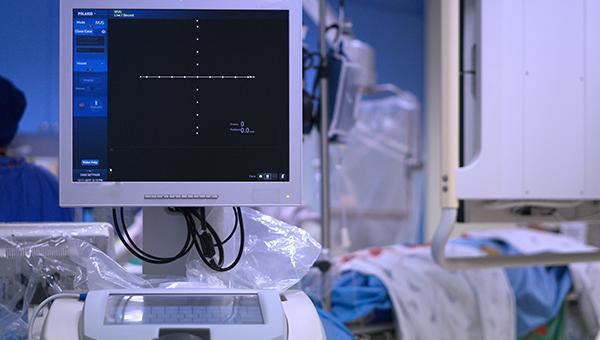Routine IVUS in Peripheral Interventions Supported by Small RCT
Adding IVUS changed treatment decisions in nearly 80% of cases and led to less restenosis at 1 year than angiography alone.

Compared with angiography alone, adding IVUS imaging to femoropopliteal artery interventions with drug-coated balloons (DCBs) results in less binary restenosis at 1 year, according to results from a single-center RCT. Yet the benefit wasn’t seen for procedures involving plain old balloon angioplasty (POBA) or stenting.
“The primary utility of IVUS appears to be accurate vessel sizing with the benefit of this being in cases treated with DCB,” write Richard B. Allan, BHlthSc (Hons), PhD (Flinders Medical Centre, Bedford Park, Australia), and colleagues. Among patients in the study who received a DCB, the 1-year rate of binary restenosis was 9.1% in the IVUS-guided group versus 37.5% in the angiography-guided group (P = 0.001).
Writing in JACC: Cardiovascular Interventions, Allan and colleagues note that high-level evidence to support the routine use of IVUS in peripheral endovascular interventions is lacking. They say their study demonstrates “that the use of IVUS can improve outcomes in femoropopliteal interventions and confirms the potential for benefit from IVUS suggested by the findings from earlier studies.”
Commenting for TCTMD, Eric Secemsky, MD, MSc (Beth Israel Deaconess Medical Center, Boston, MA), noted that despite advances in DCB and stent technology for peripheral interventions, “we are plagued by higher restenotic rates than we see in the coronary space, and we've had our issues with the paclitaxel controversy.”
This new RCT, though small, Secemsky said, “is the first one that really supports what we've been seeing in the observational literature: that if you incorporate IVUS during the femoropopliteal artery intervention to help make decisions, help size vessels, and help you decide on device implants and treatment devices, you can make an impact on restenotic rates at one year. That’s a powerful finding.”
Allan and colleagues found that IVUS had a significant influence on decision-making in the cath lab, resulting in treatment plan changes in 78.9% of cases. Examples of these changes included an increase or decrease in DCB size and/or treated segment length, as well as choice of treatment modality. In some cases, IVUS also triggered posttreatment changes that affected whether or not patients required further interventions.
“That's exactly what we do in the coronary space,” Secemsky observed. “We use IVUS to tell us what to do next, and it was clear here that . . . differences in the treatment plan were made that might have been missed on angiography alone.”
Diameter and Length Measures Differ
For the study, patients undergoing endovascular interventions involving the SFA, SFA/popliteal artery, or popliteal artery alone were randomized to imaging with angiography (n = 74) or angiography plus IVUS (n = 76). The majority of lesions in both groups were stenotic, followed by chronic total occlusions (CTOs) and restenosis. All patients had severe lifestyle-limiting claudication or Rutherford classification 4-6 critical limb ischemia (CLI).
For the entire cohort, the rate of binary restenosis at 1 year was 72.4% in the angiography group and 55.4% in the IVUS group (P = 0.008). The number of patients free of clinically driven TLR was not statistically significant between IVUS and angiography alone (P = 0.776), nor was there a difference in rates of major adverse events (P = 0.593). Additionally, unlike the DCB group where there was an advantage for IVUS, the POBA and stent groups showed no difference in rates of binary restenosis when IVUS was used or not used.
Allan and colleagues found significant differences in measurements of both reference vessel diameter (RVD) and lesion length between angiography and IVUS, with a systematic bias toward a larger RVD when IVUS was used. Compared with angiography, RVD measurements were larger in 86% of cases, smaller in 10.7%, and equal in only 3.3%. For lesion length, IVUS measurements were longer than angiography in 56.7% of cases, equal in 40.6%, and shorter in only 2.7%.
“A potential conclusion from the findings of this study might be that DCB should be routinely upsized to counteract balloon undersizing with angiography and inadequate DCB treatment,” Allan and colleagues write. “This would be a simplistic conclusion.” They say routine upsizing could result in a larger than necessary balloon size in up to 50% of patients, and instead suggest that a strategy of routine IVUS “can ensure that the balloon size matches the actual dimensions of the artery under treatment.”
Long-term Considerations
In an editorial accompanying the study, Bernardo Cortese, MD, and Erick Sanchez-Jimenez, MD (both Clinica San Carlo, Milan, Italy), suggest that there may be a connection between the larger DCB sizes and low binary restenosis rates, possibly due to a larger transfer of antiproliferative agent to the vessel wall.
“Unfortunately, this study report does not provide information regarding the role of intravascular imaging and final therapeutic strategy,” Cortese and Sanchez-Jimenez write. IVUS guidance did not lead to changes in stent sizing in the study and stent use was not associated with improved outcome when they were implanted according to the IVUS findings, they add, suggesting that more data are needed in this area. Also unknown is whether a follow-up longer than 1 year might show whether the reductions in restenosis translate to improvements in clinically driven TLR.
It’s definitely been something that's evolved in my practice, and I feel it's made me a better operator. Eric Secemsky
As Allan and colleagues note, a significant barrier to routine use of IVUS in peripheral interventions is cost, although the guidance also has the potential for cost savings if it results in a reduction in reinterventions.
“[In the US] we don't get reimbursed substantially for IVUS, but we aren’t penalized financially for using it,” Secemsky added. “The goal is that as more and more of these data come out showing the importance of IVUS, the reimbursement follows uniformly across countries.”
Secemsky noted that he finds IVUS particularly useful in below-the-knee interventions, but has increased his use of it in the last few years in all types of femoropopliteal cases. “It’s definitely been something that's evolved in my practice, and I feel it's made me a better operator,” he said.
L.A. McKeown is a Senior Medical Journalist for TCTMD, the Section Editor of CV Team Forum, and Senior Medical…
Read Full BioSources
Allan RB, Puckridge PJ, Spark JI, Delaney CL. The impact of intravascular ultrasound on femoropopliteal artery endovascular interventions: a randomized controlled trial. J Am Coll Cardiol Intv. 2022;15:536-546.
Cortese B, Sanchez-Jimenez E. Intravascular imaging for peripheral artery interventions ready for prime time? J Am Coll Cardiol Intv. 2022;15:547-549.
Disclosures
- Allan reports a health professional scholarship from the National Heart Foundation of Australia during the conduct of the study.
- Cortese and Sanchez-Jimenez report no relevant conflicts of interest.
- Secemsky reports research grants to his institution from AstraZeneca, BD, Boston Scientific, Cook, CSI, Laminate Medical, Medtronic and Philips; and consulting/speaking fees from Abbott, Bayer, BD, Boston Scientific, Cook, CSI, Endovascular Engineering, Inari, Janssen, Medtronic, Philips, and VentureMed.




Comments